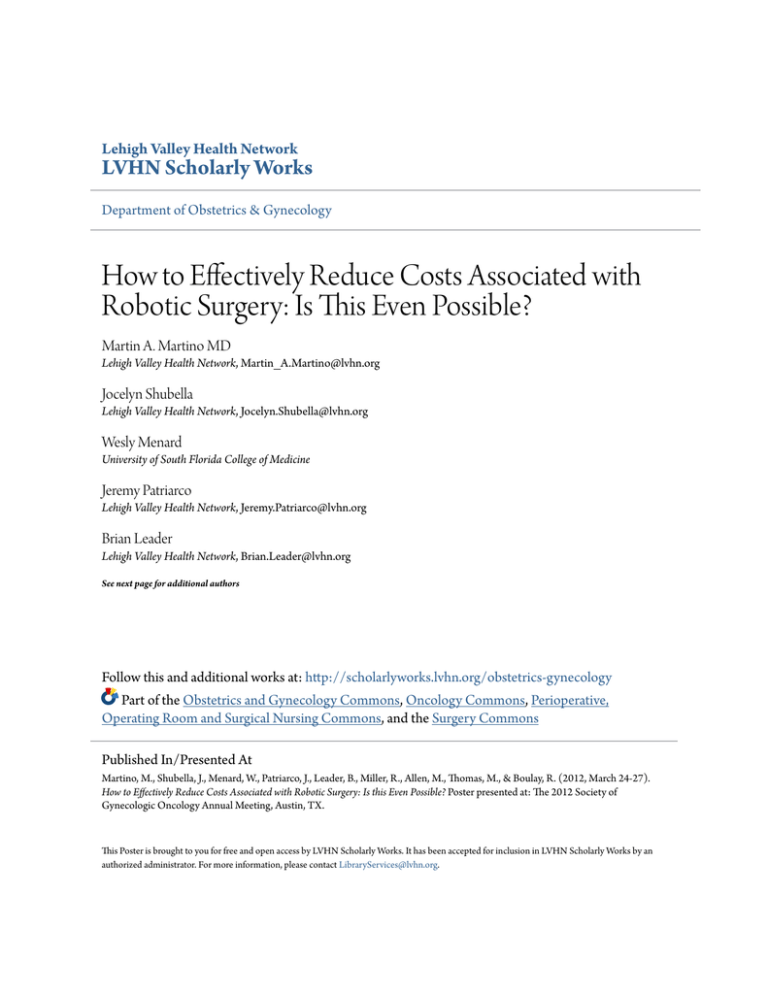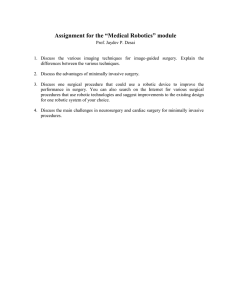How to Effectively Reduce Costs Associated with Robotic Surgery: Is
advertisement

Lehigh Valley Health Network LVHN Scholarly Works Department of Obstetrics & Gynecology How to Effectively Reduce Costs Associated with Robotic Surgery: Is This Even Possible? Martin A. Martino MD Lehigh Valley Health Network, Martin_A.Martino@lvhn.org Jocelyn Shubella Lehigh Valley Health Network, Jocelyn.Shubella@lvhn.org Wesly Menard University of South Florida College of Medicine Jeremy Patriarco Lehigh Valley Health Network, Jeremy.Patriarco@lvhn.org Brian Leader Lehigh Valley Health Network, Brian.Leader@lvhn.org See next page for additional authors Follow this and additional works at: http://scholarlyworks.lvhn.org/obstetrics-gynecology Part of the Obstetrics and Gynecology Commons, Oncology Commons, Perioperative, Operating Room and Surgical Nursing Commons, and the Surgery Commons Published In/Presented At Martino, M., Shubella, J., Menard, W., Patriarco, J., Leader, B., Miller, R., Allen, M., Thomas, M., & Boulay, R. (2012, March 24-27). How to Effectively Reduce Costs Associated with Robotic Surgery: Is this Even Possible? Poster presented at: The 2012 Society of Gynecologic Oncology Annual Meeting, Austin, TX. This Poster is brought to you for free and open access by LVHN Scholarly Works. It has been accepted for inclusion in LVHN Scholarly Works by an authorized administrator. For more information, please contact LibraryServices@lvhn.org. Authors Martin A. Martino MD, Jocelyn Shubella, Wesly Menard, Jeremy Patriarco, Brian Leader, Rachel Miller PA-C, Megan Allen RN, M Bijoy Thomas MD, and Richard Boulay MD This poster is available at LVHN Scholarly Works: http://scholarlyworks.lvhn.org/obstetrics-gynecology/10 How to Effectively Reduce Costs Associated with Robotic Surgery: Is this even possible? Martin A. Martino MD ; Jocelyn Shubella ; Wesly Menard ; Jeremy Patriarco ; Brian Leader ; Rachel Miller PA-C ; Megan Allen RN ; M. Bijoy Thomas MD ; Richard Boulay MD 1 1 2 1 1 1 1 1 1 Lehigh Valley Health Network, Allentown, PA; University of South Florida College of Medicine, Tampa, FL 1 2 Objective: The purpose of this study is to determine if transparency of surgeon metrics can reduce the actual costs associated with robotic surgery. Primary outcome measures reviewed included the direct variable operating room cost. Secondary outcome measures included total OR time and incision (cut to close) time in minutes. Results: Table 1. Patient Demographics Pre-VB (n=140) Post-VB (n=148) p value 53.2 + 12.1 55.2 + 13.4 0.187 32.9 + 7.7 33.1 + 8.0 0.908 176.1 + 183.4 166.7 + 126.2 0.618 81 80 AGE (years) Mean + SD BMI (kg/m2) Mean + SD UTERINE WEIGHT (g) Mean + SD BENIGN DIAGNOSIS 0.516 n 59 68 Conclusion: Table 2. Outcome Measures Pre-VB (n=140) Post-VB (n=148) p value $2635.39 + $767.90 $2410.96 + 677.74 0.010 234.8 + 85.3 228.7 + 85.2 0.548 165.6 + 82.7 158.4 + 85.2 0.463 DIRECT VARIABLE OR COST Mean + SD TOTAL OR TIME (min) Mean + SD INCISION TIME (min) Mean + SD Figure 1. Robotic Costs Per Case 3,000 2,536 2,500 2,405 2,491 2,254 Visibility Wall Posted 2,610 2,581 2,336 2,366 2,245 2,163 2,147 2,158 2,115 2,049 2,000 2,146 1,972 1,901 1,945 1,931 1,894 1,500 Avg Case Costs Surgeon A 1,000 Aug 02 2012 Jul 01 2012 Jun 12 2011 May 11 2011 Apr 10 2011 Mar 09 2011 Feb 08 2011 Jan 07 2011 Dec 06 2011 Nov 05 2011 Oct 04 2011 Sep 03 2011 Aug 02 2011 Jul 01 2011 Jun 12 2010 May 11 2010 Apr 10 2010 Mar 09 2010 500 Feb 08 2010 This is a retrospective cohort study of all patients who had a robotic-assisted hysterectomy from 7/1/10 to 6/30/11. All surgeries were performed by board certified gynecologic oncologists using the da Vinci S or Si surgical systems with 4 arms (including the camera arm). Studer Visibility Boards were installed in the robotic surgery rooms on 1/1/11 and their presence was emphasized to all robotic team members (Figure 1). The first six month period (7/1/1012/30/10) was identified as the pre-visibility board cohort (Pre-VB) while the latter six month period (1/1/11-6/30/11) was identified as the post-visibility board cohort (Post-VB). Demographic data reviewed included patient’s age, BMI, uterine weight, and benign versus malignant diagnosis. The direct variable cost represents all costs incurred in the operating room that are controllable by the OR 2 team. Data was analyzed using Pearson’s χ tests and Student’s ttests in SPSS. This study was IRB-approved. MALIGNANT DIAGNOSIS Jan 07 2010 Methods: n Two hundred eighty-eight patients met the inclusion criteria (140 Pre-VB and 148 Post-VB). There were no significant differences between the groups in age, uterine weight, BMI, and benign versus malignant diagnoses (Table 1). The Post-VB cohort had a significantly lower direct variable OR cost compared to the Pre-VB cohort ($2410.96 vs. $2635.39, P=.01). The lowest direct variable cost per robotic case at the conclusion of this study was $1878.00. The Post-VB cohort also experienced a shorter total OR time (229 min vs. 235 min, P=.55) and incision time (158 min vs. 166 min, P=.46) compared to their Pre-VB counterparts, even though there was no statistical significance (Table 2). The costs associated with robotic surgery may be reduced when knowledge is provided to surgical teams of the actual costs associated with each case item by using visibility boards located near robotic operating rooms. These findings suggest that reducing operating room costs is feasible through teamwork and transparent interventions.




